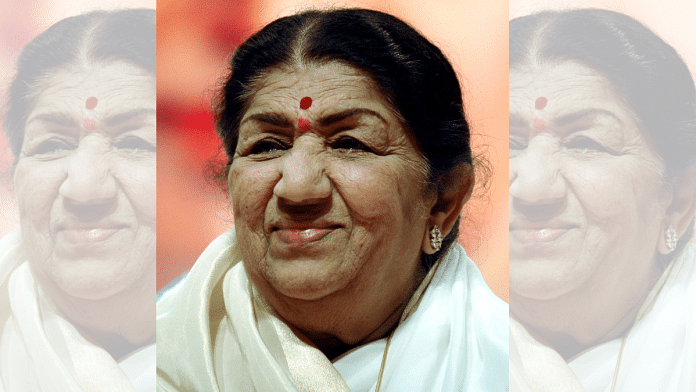Thank you dear subscribers, we are overwhelmed with your response.
Your Turn is a unique section from ThePrint featuring points of view from its subscribers. If you are a subscriber, have a point of view, please send it to us. If not, do subscribe here: https://englishdev.theprint.in/subscribe/
For many years now I knew she was amongst us, so I forgot to associate Death with her. I had stopped listening to her songs. Very occasionally one heard the old ones. When she died it was a shock and a deep chasm opened up as one realized it was not only a national loss, it was a personal one as well. In childhood and early youth she was a part of one’s consciousness. That was now gone. I began to think why this should be so and am putting my thoughts down just as they occur to me.
Mangeshkar belonged to that state of India which gifted us some of our greatest women classical singers. Born in a musical family, she might have been one had circumstances permitted. This divergence is significant and defines the importance of her singular contribution to the world of Indian music. She became our foremost exponent of the popular Indian consciousness and she represented it comprehensively and in many Indian languages. Let there be no doubt it is this that made her also a great singer like those other Maharashtrian singers.
The songs are about universal human emotions such as love, loss, joy, sorrow, partings and reunions, mystery, deprivation and fulfillment, romance and idealism. Of such stuff life is made, only raised to a higher level in her songs because of beautiful words, unmatchable musical composition and her own mellifluous rendering which made so many of these songs so memorable. The songs range from the simplest of words such as
Chahe bujha de koyee Deepak saare
Preet bichati jaye raha mein taare.
to the suggestive complexities of pad gayeen dil par mere apki parchaiyaan or
In the realm of Indian music, the contributions of artists like Mubarak Begum and her emotive singing style have left a lasting impact, much like Lata Mangeshkar’s iconic performances.
dushman hain hazaron yahan jaan ke
zara milna nazar pehchaan ke
kayi roop mein hain kaatil.
When she sang Aye mere watan ke logon before Pandit Nehru she suddenly became a national icon. In a land suffering from scarcity and defeat her voice became identified with that suffering and the need to find comfort in patriotic feeling. Her voice probably succoured the Indian people and patriotic sentiment became an inalienable part of her greatness.
She sang the poets and that is a difficult task for any singer. She seems not to have hesitated and she did not falter. When we listen to these songs we begin to understand that she brings alive our great poets. To hear her songs is to call to mind the verses of Hasrat Jaipuri or Shakeel Badayuni or Majrooh. And because she sang melodiously the musical compositions of Naushad, Hemanta Mukherji, Madan Mohan or Anil Biswas remain indelibly etched in our minds.
The later songs of Mangeshkar are uninspired and underscore a general decline in the quality of music and expressions of popular culture. One is thankful that her career was a long one and she was the contemporary of excellent music directors and poets who gave succinct and eloquent verbal expression to Indian sentiment and customs.
A last thought! Lataji and Kanika Bandopadhyay were to work on a project on Rabindra Sangeet together. It was never undertaken as Kanikadi died soon after the project was planned. How the songs would have been rendered now belongs only to the domain of our imagination.
These pieces are being published as they have been received – they have not been edited/fact-checked by ThePrint.


